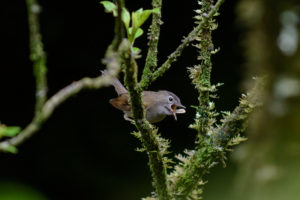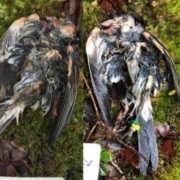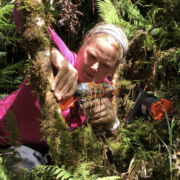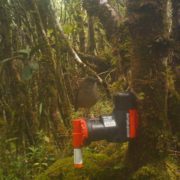Posts
124 A24s – Weapons to Fight Rats
/in Blog/by MonikaEarly October, everyone’s favorite time when the leaves start to change and all of our food and drinks contain pumpkin spice. Here on Kaua’i, we were pulling out our down jackets not to go pumpkin picking, but to venture out to our high elevation field camp on the Alaka’i Plateau. After the success we’ve had in decreasing rat numbers with the 300 self-resetting A24 rat traps that we deployed in 2015 and 2016, we felt it was important to deploy a new grid in well-established Puaiohi territories. Our research shows that nesting Puaiohi females are very susceptible to rat predation.
We’ve been in the planning stages for this new grid for several months now to find the ideal area in which to protect the most Puaiohi from rat predation. We ran habitat suitability models based on high resolution LiDAR data, looked at previous nest locations and detections, and focused on topography to see we could even access some of these areas. After all this careful planning, it was finally time to get these 124 new A24 rat traps out into the field to start protecting endangered forest birds. Our timing is good; the breeding season for Puaiohi starts in the late winter, allowing the traps to sit out all fall removing rats that could predate the birds on their nests. It is also the first time KFBRP has ever collected rat presence/absence data during fall months, leading to a more complete understanding of these invasive predators.
While hiking into camp on October 7th I was excited to see the birds again – I think so often about them, but so rarely get to spend time with them. Schlepping the heavy pack full of drills, rat traps, CO2 cartridges, and more paid off on the very first day as I was startled by a Puaiohi call while deploying a trap. I look up and a juvenile is sitting on a branch a few feet from me. Feeling fulfilled as I finish arming the trap, I now know that not only does it have the potential to save birds, but rat removal has implications for several trophic levels. A recent study on the Big Island found that “invasive rats indirectly alter the feeding behavior of native birds.” In the presence of rats, the birds foraged for insects and fruits higher in the canopy, using less of the available vertical foraging space. This change could be due to avoidance behavior by the birds or that the rats sufficiently deplete arthropod and fruit closer to ground level. The good news is that birds also responded to the removal of the invasive predators with behavioral plasticity, not just their presence. This gives me hope that our hard work can restore balance to the remaining habitat of the forest birds.
Leaving the field knowing we met our goal of deploying over 100 rat traps was gratifying, however I know we have a lot of work ahead of us to save the Puaiohi. I am restless, as I am sure the rest of the team is, to get back out the grid and hopefully see lots of dead rats and live native forest birds. These birds are facing some pretty big challenges – climate change, disease, habitat loss – and we are all happy to remove one big threat to their success.
NEW STUDY SHOWS BEST MANAGEMENT OPTIONS TO ENHANCE NATIVE BIRD SURVIVAL IN KAUAI’S FORESTS
/in Blog/by Monika The Puaiohi is a critically endangered native thrush and the last of the island’s native seed-dispersing species. As such, the Puaiohi, which numbers only 500 birds in the wild, is central to maintaining healthy native forests. Given the Puaiohi’s critical ecosystem role, small population size and restricted range, gaining a better understanding of the conditions which affect its reproduction and survival is critical.
The Puaiohi is a critically endangered native thrush and the last of the island’s native seed-dispersing species. As such, the Puaiohi, which numbers only 500 birds in the wild, is central to maintaining healthy native forests. Given the Puaiohi’s critical ecosystem role, small population size and restricted range, gaining a better understanding of the conditions which affect its reproduction and survival is critical.
To address this issue, I and other researchers at the University of Hawaiʻi at Mānoa joined with KFBRP to look at how different types of management options might influence the population size of the Puaiohi, and thus, promote the species’ long-term survival. We found that rat control, even at conservative levels, appeared to be the most effective method of increasing Puaiohi abundance. Moreover, we found that female and juvenile survival appeared to be the most important influences on population growth and persistence, indicating that management should focus on increasing female and juvenile Puaiohi survival. Both females and juveniles are very susceptible to rat predation. Other management options, such as providing nest boxes and supplemental food and improving native habitat, also have potential to increase Puaiohi numbers.
In this study, we demonstrate that practical, attainable management activities can increase Puaiohi numbers and prevent the extinction of this unique endemic species. Furthermore, the study helps justify the enormous time and effort KFBRP, its partners and the public (via the very successful “Birds, Not Rats!” campaign) is investing in rat control in the Alaka’i.
You can read the full study here. The study has also been covered by the Garden Island Newspaper and KHON and HPR.



